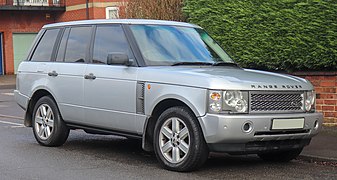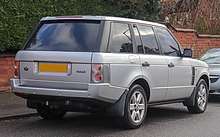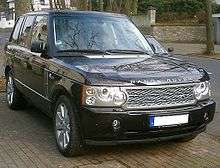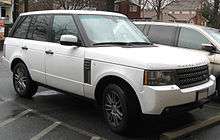Range Rover (L322)
The Range Rover (L322) (usually known simply as the "Range Rover") is the third-generation Range Rover model from British car maker Land Rover and was originally developed under the codename 'L30'.
| Range Rover (L322) | |
|---|---|
 | |
| Overview | |
| Manufacturer | Land Rover |
| Production | 2001–2012 |
| Assembly | Solihull, England |
| Designer | Phil Simmons (1997)[1] Wolfgang Reitzle (1998) |
| Body and chassis | |
| Class | Full-size luxury SUV |
| Body style | 5-door SUV |
| Layout | Front engine / four-wheel drive |
| Powertrain | |
| Engine | Petrol BMW 4.4 L V8 (2002–2006) Jaguar 4.4 L V8 (2006–2009) Jaguar 4.2 L S/C V8 (2006–2009) Jaguar 5.0 L N/A V8 S/C V8 (2009–2012) Diesel BMW 2.9 L TD6 (2002–2006) Ford 3.6 L TDV8 (2007–2010) Ford 4.4 L TDV8 (2010–2012) |
| Transmission | Automatic 5-speed GM5L40E 5 speed transmission in TD6 ZF 5HP (2002–2005) 6-speed ZF 6HP (2006–2012) 8-speed ZF 8HP[2] (2010–2012) |
| Dimensions | |
| Wheelbase | 2,880 mm (113.4 in) |
| Length | 4,950 mm (194.9 in) (2002–2005) 4,971 mm (195.7 in) (2005–2009) |
| Width | 1,923 mm (75.7 in) (2002–2009) 2,035 mm (80.1 in) (2009–2012) |
| Height | 1,862 mm (73.3 in) (2002–2005) 1,902 mm (74.9 in) (2005–2009) |
| Chronology | |
| Predecessor | Range Rover (P38A) |
| Successor | Range Rover (L405) |
The L322 was introduced in 2001 and had a production run of over ten years. Planned and developed under BMW ownership, the vehicle was intended to share components and systems (electronics, core power units etc.) with the E38 7 Series. However, BMW had already sold Land Rover to Ford some two years before the L322 went into commercial production.
In the UK and many other territories, ascending trim levels were initially marketed as "SE", "HSE" and "Vogue". Various other trims such as "Vogue SE", "Westminster", "Autobiography" and special editions were subsequently produced.
In his Sunday Times column, Jeremy Clarkson once went on record to state that he owned a Range Rover TDV8 Vogue and it was ‘the best car in the world and best 4x4.’[3]
The L322's successor, the L405, was announced in August 2012 and unveiled the same year at the Paris Motor Show.
Overview
The previous generation P38 Range Rover (or "Pegasus") had been developed whilst the Rover Group was owned by British Aerospace, and budgetary constraints during the development had been extremely tight. There was also press criticism of the P38A that its styling lacked the "presence" of the original 1970 Range Rover. When the Rover Group was taken over by BMW shortly after the P38A's launch in 1994, the newly installed BMW management at Land Rover quickly concluded that the car would not have a long shelf life compared to its predecessor, due to its fundamentally dated underpinnings, and cancelled the planned '99 Model Year' updates. A proposed replacement for the Discovery was postponed and development of an all-new Range Rover, codenamed L322, took priority.
The initial codename for the project was L30, in line with the then system of Lxx for Land Rover projects, such as Freelander (L20) and Discovery2 (L25).
The L30 project was a joint one involving engineers from both Rover Group and BMW and was initially based at BMW's FIZ Engineering Centre in Munich before transferring to Land Rover's Solihull plant for the final stages prior to volume production. Munich was chosen to house the team as Rover Group's Gaydon Engineering facility was already working on the new MINI (R50) project as well as other MG, Rover and Land Rover projects and did not have enough space for another large engineering team to be based there.
The sale of Land Rover by BMW to Ford occurred just before the move to Solihull and the contract included a clause which continued BMW's involvement until after the car had entered volume production.
The switch to Lxxx codenames occurred after the sale to Ford with L30 being renamed L322 at the top of a model line-up of Range Rover Sport (L320) Land Rover Discovery (Discovery3 L319), Land Rover Defender (L316) and Freelander (L314).
The third-generation Range Rover was designed to accommodate BMW's M62 V8 engines for future models. The manual transmission was dropped entirely, leaving only the automatic transmission. The BMW 7 Series E38 electronics system were being phased out during the development of the third-generation Range Rover, and being replaced with the electronics from the BMW E39 5 Series. The entertainment system (Radio Function, Navigation System, Television and Telecommunications systems, as well as the automotive computer bus system)[4] on pre-facelift models were almost identical to those in the BMW E39 5 Series. Early models of the third-generation model Range Rover could be upgraded with some newer BMW technologies, although from 2005 onwards the electronics were based on Ford/Jaguar systems.[5]
Initial release

The design has a monocoque (unibody) construction with four-wheel independent air suspension. Air suspension allowed variable ride height and achieved similar axle articulation to the previous live axle design. This retained off-road abilities while improving on-road performance.[6][7][8] The new Range Rover's introduction in early 2002 as a 2003 model for the North American market resulted in the Range Rover and Ford Expedition (also new for 2003) being the only two SUVs in the full-size sport utility class with four-wheel independent suspension systems at that time.
Early US-specification Range Rover included air conditioning with tri-zone climate controls with interior air filter, power tilt/telescopic leather-wrapped steering wheel with radio controls, cruise control, memory system, leather upholstered twelve-way power driver seats, ten-way power passenger seat, power sunroof, a premium sound system with six-disc CD changer, navigation system with voice activation, rearview camera, wireless mobile phone link, universal garage door opener, and outside-temperature indicator. Options included 14-way power heated/cooled front seats, DVD entertainment system, and upgraded leather upholstery.
2005

- 2005
At the 2005 North American International Auto Show, a major update of the Range Rover was unveiled, with the base model using the LR3/Discovery 3 engine, and a premium model using a supercharged version of the Jaguar 4.2-litre V8 developing 400 hp (298 kW) — the same engine slated for the new Range Rover Sport (the RRS model uses a detuned variant making a total of 389 bhp (290 kW; 394 PS)), scheduled for introduction about the same time (mid-2005) as the updated Range Rover.
The engines are aluminium alloy units, with advanced torque-based engine management system, drive-by-wire throttle control, and variable camshaft phasing (on the 4.4-litre version).
2006
.jpg)
The Range Rover's exterior was updated for 2006 along with the BMW V8 being replaced with a Jaguar unit. The new engine choices were Jaguar's AJ-V8, with 4.4-litre 300 hp (220 kW) or 4.2-litre 400 hp (300 kW) supercharged variants. This new Range Rover was officially presented at the 2005 North American International Auto Show and released in summer 2005.
From the diesel engine of the 2006 model (at this time still the BMW six-cylinder unit) to the supercharged V8, the car could reach 60 mph (97 km/h) from 14.8 seconds or as little as 6.5 seconds and has a top speed from 110 mph (180 km/h) to approximately 130 mph (210 km/h) (governed), respectively.
In addition to the engine change, the 2006 Range Rover is equipped with an updated "infotainment" system. This includes a touch screen with on and off-road navigation, radio, CD, Satellite Radio (US), telephone, rear view camera, a wireless video camera system and other additional features all accessed via the same user interface. The audio system is Harman Kardon Logic 7 surround sound. Also available is a DVD rear seat entertainment which is fully integrated.
This system is linked by an industry-standard fibre optic network known as Media Oriented Systems Transport or MOST and an electronic network system known as CAN bus. A similar system is also used on Land Rover Discovery and Range Rover Sport.
Suppliers for the 2006 Range Rover's components include Continental Automotive for the complete cockpit module which incorporates the Denso touch screen navigation unit. Continental also supply the centre console unit. Other suppliers include Alpine car audio for integrated head unit rear seat entertainment. Connaught Electronics Limited (CEL) provides the Rear View Camera (RVC) and Wireless Camera (VentureCam) systems and PTI telephone capabilities are provided by Nokia.
Most importantly the audio system was co-developed with Harman Kardon. The premium offering gives a 720 Watt, 14-speaker system and was the first OEM vehicle to use the discrete Logic 7 surround algorithm.
2007
For 2007, many of the Range Rover's changes were mechanical or interior. However, the external C-pillar was given a glass facelift akin to that of the Range Rover Sport, marking a subtle and yet clear departure from the original BMW influenced design.
On the inside, the hidden folding cup holder that popped out of the end of the dashboard in previous models was replaced by a simpler and more durable in-console design with sliding covers (similar in concept, but higher quality, to those in the Range Rover Sport). The ignition switch was moved from the lower part of the centre console up to the dashboard, next to the steering wheel and the Range Rover received the Range Rover Sport / LR3's Terrain Response system as well as a redesigned four-wheel drive control panel.
The handbrake is now electronic. Additionally, the seats differ from the old style, resembling the new Range Rover Sports seat design. Heated seats are standard across the board, with newly available climate controlled front seats standard on all supercharged trims and HSE Luxury/Vogue, with three settings for cool air and hot air activated by round dials on both sides of the analog clock on the part of the center control stack, and the premium leather seats from the BMW era are no longer available, with new more premium quality leather in different grains for HSE/Vogue, SE/Vogue, HSE Luxury/ Vogue and all supercharged trims. The HVAC system was also updated with more vents and quieter operation. That, along with the acoustic laminated/heated windscreen lowers noise. An increase in interior storage is mainly attributed to the new split-dual glovebox. And then in a return to original Range Rover styling, more wood inserts have been added to the doors and centre console. Midway through production of the 2007 model (around production date of January 2007) the style of the key was changed from the BMW design to Land Rover's "switchblade" type.
The BMW M57 diesel engine was replaced for 2007 with the TDV8 engine developed by Ford and Land Rover at Dagenham and Gaydon. The 3.6-litre AJD-V8 32-valve twin turbo V8 engine develops 272 hp (203 kW), far more than the 177 hp (132 kW) of the previous engine and so is better capable to deal with the weighty vehicle. The maximum speed is 124 mph, whilst 0-60 mph was reduced to 8.6 seconds for a car with a kerb weight of 2.7 tons. Torque is a substantial 472 lb/ft (640Nm) at 2,000 rpm.
Other changes for 2007 include better brakes, revised suspension, and Land Rover's Terrain Response system. Supercharged Range Rovers have an electronic rear differential (optional on other models).
2010 model year

For the 2010 model year refresh, the Range Rover received an updated exterior grille, a multicamera vision system, front bumper with newly repositioned fog lights lower in the bumper, LED accented bi-xenon headlights/LED tail/brake lights with front and rear amber LED turn signals with a three bar design, optional blind spot assist and adaptive auto high beam headlights which are now part of the new for 2010 vision assist package optional on the HSE and HSE with the luxury package, standard on all supercharged trims. Two new petrol engines (5.0 naturally aspirated V8 and 5.0 supercharged V8),[9] and new features. It was unveiled at the 2009 New York Auto Show.
_TDV8_wagon_(2012-09-01).jpg)
The interior of the Range Rover was given a minor facelift, consisting mainly of redesigned and repositioned switchgear (which saw many of the originally BMW era designed items updated or replaced), along with new options never before available for Range Rover like the addition of push button engine start/stop . The 2010 Range Rover also gained new visual display units as also seen in the new for 2010 Jaguar XJ (X351). This change consisted of a 12-inch TFT LCD virtual instrument panel, which replaces the conventional cluster design — instead 'virtual' gauges are displayed where physical analog gauges were previously. This allows various sets of information to be displayed as required — for example navigation and map information can be displayed instead of engine readouts, whilst when one of the off-road driving modes is selected on the Terrain Response system the 'gauges' are reorganised to provide space to display the schematic of the vehicle's suspension, steering and transmission systems. The other display unit is fitted to the centre console and uses a bi-directional screen to show different images depending on viewing angle (may not be available in the US). This allows navigational information to be displayed to the driver, whilst someone in the front passenger seat can use the same screen to use the onboard DVD player at the same time, for example. This system also contains a state-of-the-art multi-camera system from Valeo Vision Systems in Ireland, which allows the driver to see around the vehicle during manoeuvres and which contains multiple overlays and views.[10]
Holland & Holland
Unveiled in early 2010, the Holland & Holland edition Range Rover is billed as an all season luxury supercar. It is not an official Land Rover limited edition, the model is produced by Overfinch using a standard Range Rover furnished with unique features using Holland & Holland as design consultants. Supplied to Overfinch unfurnished and sometimes unpainted, when complete they can be maintained officially through any Land Rover dealership. The cars can be finished in five unique colours including Tintern Green, a famous Holland & Holland colour; the cars can also be specified with two-tone leather and extended walnut trim, which can be colour matched to a customer's gun. Features unique to the Holland & Holland include a bespoke rear console and refrigerator including power outputs and storage for branded crystal tumblers. In the boot, all Holland & Holland cars have a gun box fully furnished and including a drinks cabinet. Either the 4.4 TDV8 or 5.0 Supercharged engines can be chosen, both with extra power, the cars also feature a modified 'Aero 3' Overfinch body kit to distinguish them from other Range Rovers.
2011 model year
The 2011 model year Range Rovers include minor styling changes, improved interiors and an upgraded 4x4 system as well new optional packages.[11] A new 4.4-litre TDV8 diesel engine became available with a new ZF 8HP70 eight-speed automatic transmission. There are also new leather and wood colours, as well as reclining rear seats with winged headrests. A new Autobiography Black model features a different grille, Barolo Black paintwork, and a choice of Jet/Ivory or Jet/Pimento interiors.
Production
Honeywell Turbo Technologies produced the turbochargers used in LR-TDV8 engine from 2011 in the new 4.4 TDV8 due to reliability issues on the 3.6 TDV8 setup.[12]
Specifications
Engines
| Model | Years | Engine type | Power at rpm | Torque at rpm |
|---|---|---|---|---|
| 4.4 L V8 | 2002-2005 | 4,398 cc (268 cu in) DOHC V8 (BMW M62) | 286 PS (210 kW; 282 hp) at 5,400 | 440 N⋅m (325 lbf⋅ft) at 3,600 |
| 3.0 L Td6 Diesel | 2002-2005 | 2,926 cc (179 cu in) Inline-6 Turbodiesel (BMW M57) | 177 PS (130 kW; 175 hp) at 4,000 | 390 N⋅m (288 lbf⋅ft) at 2,000 |
| 4.2 L V8 Supercharged | 2005-2009 | 4,197 cc (256 cu in) V8 Supercharged (Jaguar AJ-V8) | 400 PS (294 kW; 395 hp) at 5,750 | 560 N⋅m (413 lbf⋅ft) at 3,500 |
| 4.4 L V8 | 2005-2009 | 4,394 cc (268 cu in) V8 (Jaguar AJ-V8) | 305 PS (224 kW; 301 hp) at 5,750 | 440 N⋅m (325 lbf⋅ft) at 4,000 |
| 3.6 L TDV8 Diesel | 2006-2010 | 3,630 cc (222 cu in) V8 Twin-Turbo Diesel (AJD-V8) | 272 PS (200 kW; 268 hp) at 4,000 | 640 N⋅m (472 lbf⋅ft) at 2,000 |
| 5.0 L V8 | 2009-2012 | 4,999 cc (305 cu in) V8 (AJ133) | 375 PS (276 kW; 370 hp) at 6,500 | 510 N⋅m (376 lbf⋅ft) at 3,500 |
| 5.0 L V8 Supercharged | 2009-2012 | 4,999 cc (305 cu in) V8 Supercharged (AJ133) | 510 PS (375 kW; 503 hp) at 6,000-6,500 | 625 N⋅m (461 lbf⋅ft) at 2,000-2,500 |
| 4.4 L TDV8 Diesel | 2010-2012 | 4,367 cc (266.5 cu in) V8 Twin-Turbo Diesel (AJD-V8) | 313 PS (230 kW; 309 hp) at 4,000 | 700 N⋅m (516 lb⋅ft) at 1,500-3,000 |
By the time of the launch, Land Rover had been sold to Ford in 2000, as part of the splitting up of the Rover Group. As a result, the initial engine derivatives were not included in the sale.
Limited editions and cooperations
- 20th Anniversary Edition
To celebrate twenty years in North America, Land Rover produced the 20th Anniversary Edition Range Rover, of which only forty were produced. Each vehicle is a supercharged Range Rover in a special pearl white paint with "Diamond" split-spoke 20-inch wheels and a unique, two-tone interior. Badges on the tailgate and door sills denote the vehicle as such and lists its production number out of the 40. Only one of each model was distributed per dealer, and the dealerships were chosen in a lottery. The 40th model was auctioned at a silent auction to benefit charity.
- 35th Anniversary Edition
This was a UK spec production run, with 35 cars finished in Claret coachwork with 2-tone claret/jet interiors. The specifications were based on the Vogue SE and fitted with the 4.2-litre supercharged 400 bhp (298 kW; 406 PS) Jaguar V8.
- Armoured Range Rover
An armoured Range Rover Vogue was developed by Land Rover Special Vehicles in 2007, in cooperation with Armour Holdings Group. The vehicle was certified for European B6 ballistic protection standard. It includes side-blast and under-floor grenade protection, uprated suspension, handling and braking system, wheels fitted with run-flat tire system, and fuel cut-off override. Optional security features include tinted windows, anti-tamper exhaust, and intercom.[13]
- Autobiography Ultimate Edition
A special edition produced wholly by Land Rover. In the front, the car is little different from a standard Autobiography, more wood finishes are offered, as are a few unique trim pieces. The difference is in the rear cabin, which is furnished with two iPads, a fixed armrest with metal laptop desk, electric reclining climate-controlled seats, and a refrigerator. The car can be ordered in two colours, with 20-inch wheels, body-coloured door handles and smoked grills and gills. 50 cars were produced.
In media
In the feature film Cars 2, the character Miles Axlerod was based on a modified Range Rover (L322).
References
- https://www.aronline.co.uk/cars/range-rover/l322/concepts-and-prototypes-range-rover-l322/
- "Range Rover: Birthday Child with new Transmission Technology". Archived from the original on 19 January 2011. Retrieved 24 August 2010.
- Clarkson, Jeremy (15 March 2009). "Range Rover TDV8 Vogue SE". The Sunday Times. ISSN 0956-1382. Retrieved 18 October 2019.
- "BMW Bus System" (PDF). Retrieved 2 August 2010.
- "RoverUpgrades". RoverUpgrades. Retrieved 2 August 2010.
- Rangerovers.net. "Model Specs L322 Development". Retrieved 11 April 2008.
- Rangerovers.net. "L322 Development details". Retrieved 11 April 2008.
- Rangerovers.net. "L322 Development further details". Archived from the original on 4 June 2002. Retrieved 11 April 2008.
- Engines & Transmission Land Rover. Retrieved on 2009-01-12.
- In-Car Technology Land Rover. Retrieved on 2009-01-12.
- Range Rover 2011MY Motorward. Retrieved on 2010-06-17.
- Honeywell Turbo Innovations Launched on High Performing Mercedes, Range Rover Engines
- "Range Rover Vogue Security Vehicle: Land Rover announces its first armoured production model". Carscoop.blogspot.com. 27 March 2007. Retrieved 2 August 2010.